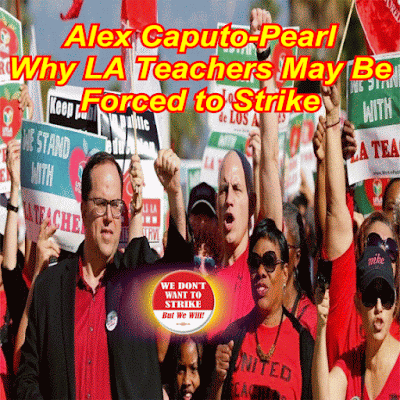The Radical Organizing That Paved the Way for LA’s Teachers’ Strike
In 2014, a progressive Union Power caucus took over UTLA—and that has made all the difference.

There are three picket lines at the Harry Bridges Span School in Wilmington, California, on the morning of Wednesday, January 16, but the one in front of the gate is where the action is. There’s a truck driver there to make a delivery. He’s looked at the picket line and kept on driving for the previous two days, to the jubilation of the rallied teachers, parents, and neighbors holding the line. But today his supervisor is there, and it appears the supervisor has called the police to clear the way for the drivers.
The teachers are facing off with the police officers—one teacher is in tears—as they explain why they think fellow unionized workers should stand with them, not try to cross the line. One woman taps my shoulder, saying, “The police should be going after bad people, not teachers!” Another picketer asks where all these police cars are when someone gets shot.
But the line holds. The police don’t make good on their threats to cite or arrest teachers, and the truck and police cars drive off. One of the officers even gets on his radio before he leaves and says, “Don’t let them come between us. We support you!”
Four days into the United Teachers Los Angeles (UTLA) strike, the picket lines are working like well-oiled machines—and the groundwork that union reformers put into reshaping a massive organization into a fighting union, one that has taken over the city with mass rallies and pickets, is showing. So is the work the union has put into building community alliances, as parents, students, and community groups continue to organize solidarity actions that include visits to the homes of schoo-board members and charter-school funders. The UTLA strike, which leadership has called “a battle for the soul of public education,” at this point looks to be a model for how to keep public-sector unions strong in the age of Janus Janus v. American Federation of State, County, and Municipal Employees.
It’s still raining—it has been since Monday, the first day of the strike—but that doesn’t stop anyone. Phyllis Hoffman, the chapter leader at Harry Bridges school, and Michael Gearin, the “cluster leader” who coordinates with other local schools, are running around. They’re talking with police, leading chants, accepting donations of donuts, coffee, and breakfast CONTINUE READING: The Radical Organizing That Paved the Way for LA’s Teachers’ Strike | The Nation





